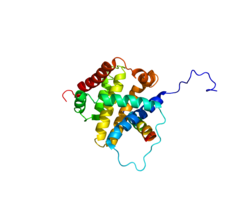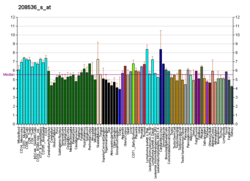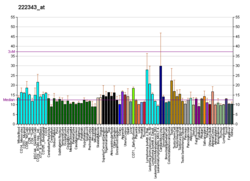BCL2L11
| BCL2L11 | |||||||||||||||||||||||||||||||||||||||||||||||||||
|---|---|---|---|---|---|---|---|---|---|---|---|---|---|---|---|---|---|---|---|---|---|---|---|---|---|---|---|---|---|---|---|---|---|---|---|---|---|---|---|---|---|---|---|---|---|---|---|---|---|---|---|
 | |||||||||||||||||||||||||||||||||||||||||||||||||||
| Structure de la protéine BCL2L11. Basée sur l'identifiant PDB 2K7W. | |||||||||||||||||||||||||||||||||||||||||||||||||||
| |||||||||||||||||||||||||||||||||||||||||||||||||||
| Identifiants | |||||||||||||||||||||||||||||||||||||||||||||||||||
| Aliases | BCL2L11, Bcl-2-like protein 11, BIM | ||||||||||||||||||||||||||||||||||||||||||||||||||
| IDs externes | OMIM: 603827 MGI: 1197519 HomoloGene: 7643 GeneCards: BCL2L11 | ||||||||||||||||||||||||||||||||||||||||||||||||||
| |||||||||||||||||||||||||||||||||||||||||||||||||||
| |||||||||||||||||||||||||||||||||||||||||||||||||||
| |||||||||||||||||||||||||||||||||||||||||||||||||||
| |||||||||||||||||||||||||||||||||||||||||||||||||||
| |||||||||||||||||||||||||||||||||||||||||||||||||||
| Wikidata | |||||||||||||||||||||||||||||||||||||||||||||||||||
| |||||||||||||||||||||||||||||||||||||||||||||||||||
Bcl-2-like protein 11, communément appelée BIM, est une protéine qui, chez l'homme, est codée par le gène BCL2L11[5],[6].
Fonction
La protéine codée par ce gène appartient à la famille des protéines BCL-2. Les membres de la famille BCL-2 forment des hétérodimères ou des homodimères et agissent comme des régulateurs anti ou pro-apoptotiques participant à une vaste gamme d'activités cellulaires. La protéine codée par ce gène contient un domaine homologique Bcl-2 3 (BH3). Il a été démontré qu'il interagit avec d'autres membres de la famille de protéines BCL-2, y compris BCL2, BCL2L1/BCL-X(L), et MCL1, et qu'il agit comme activateur apoptotique. L'expression de ce gène peut être induite par un facteur de croissance nerveuse (NGF)[7].
Références
- ↑ a b et c GRCh38: Ensembl release 89: ENSG00000153094 - Ensembl, May 2017
- ↑ a b et c GRCm38: Ensembl release 89: ENSMUSG00000027381 - Ensembl, May 2017
- ↑ « Publications PubMed pour l'Homme », sur National Center for Biotechnology Information, U.S. National Library of Medicine
- ↑ « Publications PubMed pour la Souris », sur National Center for Biotechnology Information, U.S. National Library of Medicine
- ↑ Hsu SY, Lin P, Hsueh AJ, « BOD (Bcl-2-related ovarian death gene) is an ovarian BH3 domain-containing proapoptotic Bcl-2 protein capable of dimerization with diverse antiapoptotic Bcl-2 members », Mol Endocrinol, vol. 12, no 9, , p. 1432–40 (PMID 9731710, DOI 10.1210/mend.12.9.0166)
- ↑ O'Connor L, Strasser A, O'Reilly LA, Hausmann G, Adams JM, Cory S, Huang DC, « Bim: a novel member of the Bcl-2 family that promotes apoptosis », EMBO J, vol. 17, no 2, , p. 384–95 (PMID 9430630, PMCID 1170389, DOI 10.1093/emboj/17.2.384)
- ↑ « BCL2L11 BCL2 like 11 [Homo sapiens (human)] - Gene - NCBI », sur www.ncbi.nlm.nih.gov (consulté le )
- (en) Cet article est partiellement ou en totalité issu de l’article de Wikipédia en anglais intitulé « BCL2L11 » (voir la liste des auteurs).
 Portail de la biochimie
Portail de la biochimie


















